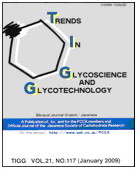All issues

Volume 24 (2012)
- Issue 140 Pages 231-
- Issue 139 Pages 193-
- Issue 138 Pages 137-
- Issue 137 Pages 95-
- Issue 136 Pages 47-
- Issue 135 Pages 1-
Volume 24, Issue 138
Displaying 1-5 of 5 articles from this issue
- |<
- <
- 1
- >
- >|
MINIREVIEW
-
Akihiko Kameyama, Yu-ki MatsunoArticle type: MINIREVIEW
2012 Volume 24 Issue 138 Pages 137-151
Published: 2012
Released on J-STAGE: August 09, 2012
JOURNAL FREE ACCESSTumor-associated structural alterations of O-linked glycans in mucins have often been reported. However, mucin characterization has been lagging following adoption of modern techniques such as proteomics because of their large size, polymeric nature, and heterogeneous glycosylation. For mucins to be used as biomarkers, a convenient and high-throughput technology for characterization of mucins including analysis of glycan moieties must first be developed. Supported Molecular Matrix Electrophoresis (SMME) is a membrane electrophoresis in which hydrophilic polymer soaking into a porous membrane such as polyvinylidene difluoride (PVDF) is used as the separation medium. The electrophoretic conditions for cellulose acetate membrane electrophoresis can be applied to SMME without significant modifications. Treatment of the SMME membrane under alkaline β-elimination conditions does not induce degradation products of hexose oligomers that would otherwise interfere with glycan analysis. This technique was applied to the characterization of MUC1 produced by three cancer cell lines (T47D, HPAF-II, and BxPC3).View full abstractDownload PDF (2562K) -
Natsuhisa Oka, Kazuki Sato, Takeshi WadaArticle type: MINIREVIEW
2012 Volume 24 Issue 138 Pages 152-168
Published: 2012
Released on J-STAGE: August 09, 2012
JOURNAL FREE ACCESSPhosphoglycans consisting of glycosyl phosphate repeating units have received much attention as synthetic targets mainly for their potential use as vaccines against pathogenic bacteria and protozoa. This review describes recent progress in the synthesis of glycosyl phosphates, especially of phosphoglycans, focusing on methods of synthesizing intersaccharide phosphodiester linkages.View full abstractDownload PDF (4318K) -
Yayoi Yoshimura, Hidenori Tanaka, Norman J. Dovichi, Ole Hindsgaul, Mo ...Article type: MINIREVIEW
2012 Volume 24 Issue 138 Pages 169-178
Published: 2012
Released on J-STAGE: August 09, 2012
JOURNAL FREE ACCESSGlycosphingolipids (GSLs) are important components expressed at the cell surface, where they play numerous roles in biological processes. The analysis of GSL metabolism is important but remains challenging in part due to the complexity of the components. To better understand the functions of GSLs on single cell scale we are developing an analytical method that uses fluorescently-tagged GSL analogs and capillary electrophoresis with laser induced fluorescence detection. We are applying this method to monitor glycolipid metabolism in single cells. In this article, we summarize our methodology, show examples of the chemo-enzymatic synthesis of glycolipid analogs, and provide some experimental data in single cell analysis.View full abstractDownload PDF (2174K) -
Akihiro Ishiwata, Ayaka Sakurai, Yukishige ItoArticle type: MINIREVIEW
2012 Volume 24 Issue 138 Pages 179-189
Published: 2012
Released on J-STAGE: August 09, 2012
JOURNAL FREE ACCESSEnormous rate acceleration was observed when O-glycosylation was conducted in p-xylene below its freezing point, as determined by comparative studies under both frozen and unfrozen conditions. The mechanistic implications of stereoselectivity on glycosylation under frozen systems were also investigated. Examination of the effects of various factors, such as solvent, concentration, anomeric configuration and protective groups of the donor, revealed that the stereoselectivity was affected by concentration both in liquid and in frozen conditions. The rate acceleration in frozen solvent was caused by the highly concentrated environments found therein. The substrate concentration under frozen conditions was estimated to be about 50 times higher than that before freezing. This manuscript also summarizes the application of this technique to the synthesis of complex glycans as well as bioactive molecules.View full abstractDownload PDF (1583K)
GLYCOTOPIC
-
Kiichiro TotaniArticle type: GLYCOTOPIC
2012 Volume 24 Issue 138 Pages 190-192
Published: 2012
Released on J-STAGE: August 09, 2012
JOURNAL FREE ACCESSDownload PDF (405K)
- |<
- <
- 1
- >
- >|